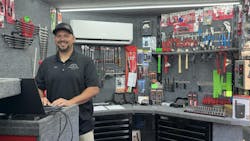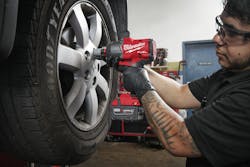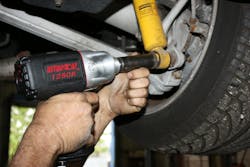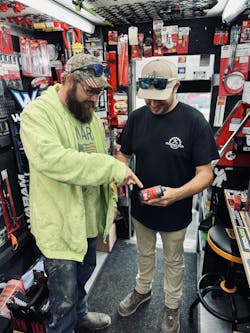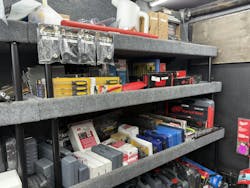Key Highlights
- Cordless design, smart features, and ease of use make electric tools ideal for light-to-medium duty, precision-focused tasks.
- Continuous power, durability, and high torque keep air tools essential for heavy duty and high-volume shop work.
- Customer tool preferences can depend on the type of shop and its workload; understanding these individual needs can help you know what to stock
- Asking the right questions about buyer preferences, tasks, and budgets helps guide tool recommendations.
- Shop layout, compressor availability, and mobility needs determine whether electric or air tools make more sense.
A technician’s toolbox is filled with a variety of tools and equipment. As years pass, some of those tools become obsolete. Currently, the automotive industry is seeing a trend where technicians and shops are buying more cordless electric tools than air tools. However, this trend doesn’t mean air tools are over.
Independent distributor Nick Smalley and his team of distributors are seeing this trend as well. Smalley and one of his drivers, Collin Kenehan, both note that when it comes to the sale of electric tools, they sell anywhere from a few daily to a few weekly, while their air tool sales are more often a few monthly.
Electric tools and air tools each have their strengths and weaknesses, creating their own places in a shop. During PTEN’s annual Aftermarket Profile Survey (featured in our April issue), we asked shop owners and technicians whether they prefer air tools or electric tools and if they’re replacing their air tools with electric tools. In terms of preference between air tools and electric tools, the split was pretty even. About 50 percent said they prefer electric while the other 50 percent prefer air tools, or have no preference. As for replacing their air tools with electric tools, only 5 percent of technicians have replaced all of their air tools. Seventeen percent have not replaced any, and 77 percent have replaced some, but are keeping a mix between the two.
Every technician will have their own preferences about what tools they use and when. As Matt McKegney, North American Sales Manager for AIRCAT Pneumatic Tools, notes, “It’s all based on the application.”
Pick your fighter: Electric tools vs. air tools
Though cordless electric tools are the current trend, your customers are still using and buying new air tools. This means understanding the differences between these tools and the applications they are best used for is important so that you can help your customers get the right tool for the job.
Electric tools
One key attribute of electric tools is their ability to be cordless. This grants technicians the ability to move around the shop freely and get into tight spaces more easily.
“Cordless is no longer just about convenience,” says Milwaukee Tool’s Group Manager of Product Marketing, Ryan Mack, “It’s about delivering greater productivity, safety, and freedom in the shop. For example, technology now being integrated into our High Torque Impact Wrench solutions can target torque range to prevent over torquing, ultimately reducing rework and improving safety.”
Other “smart” features offered in some electric tools include automatic shut-off and performance tracking for precision, notes C.J. Fay, digital and brand senior marketing manager for SUNEX Tools.
Fay continues on to say that electric tools are best suited for light to medium duty tasks with precise torque control, providing versatility to the user. Additionally, because no equipment is required to use these tools, as they are either plug-and-play or battery-powered, it makes them simple to use.
Air tools
When it comes to air tools, their ability to be continually used — no wait time for batteries to be recharged — makes them an ideal choice for high-volume tasks, notes Fay. These tools tend to excel in high-power, shop-based tasks such as heavy duty bolting. Air tools also often come into play during body shop repairs and are used for metal fabrication, bodywork, surface prep, and automotive painting to get a uniform application.
McKegney also sees much use of air tools for collision-based repairs.
“Right now, we still see the continuous running tools, which we call rotary tools, which are sanders, die grinders, those types of tools, [where] air still is preferred just because of the performance and the weight,” McKegney says. “So, it all depends on the application … determining what the technician is going to use.”
Fay goes on to add that the adjustable power output technicians have via the air compressor settings allows for quite a bit of versatility from task to task. Lastly, he mentions that air tools tend to have greater durability due to having fewer moving parts. This helps to ensure a long lifespan in the potentially harsh conditions of an auto shop.
Understanding your customers
Every route and each stop along its way hosts a variety of unique customers with individual needs. Smalley and his team’s routes are located throughout Wisconsin and Northern Illinois. They stop at dealerships, independent shops, truck shops, body shops, and perhaps unsurprisingly, boat shops and individual farms. Each of those locations has different needs for tools and equipment.
Smalley notes that he visits many of the heavy duty shops and agricultural locations along his route, so the tools and equipment he carries are more heavy duty based. Shop type can also play a role in whether those technicians are interested in electric or air tools.
“Heavy duty shops seem to like air,” Kenehan says. “[Technicians] need 1” anvils, 3/4", and there's not an electric air hammer yet. So, air hammers are a great tool to have [in those shops.]”
Smalley and his team keep multiple electric and air tool brands on their trucks to suit all their customers’ needs. For electric, they’ve got Milwaukee, DeWalt, and Makita, and for air tools, they have AIRCAT, Ingersoll Rand, Astro, and Mityvac. If there’s a brand or a tool they don’t have, they’ll work with the customers to get them what they need.
Often, when customers approach them about buying an electric or air tool, the customer has already done the research.
“Most guys will come on the truck, and they'll say, ‘Hey Nick, do you have that? Do you have that Astro THOR air hammer? We read online that that's the closest comparison to [this other] air hammer,’ Smalley explains. “When it comes to air tools, guys come on the truck, knowing what they want, usually down to the specific model number.”
Electric tools aren’t very different, especially when it comes to the Milwaukee Tool products.
“The Milwaukee stuff just sells itself because it's everywhere,” Smalley says. “The information is everywhere; the hype is everywhere. So again, guys know what they want. It's kind of an easy sell for us, because we don't have to explain what it is.”
Understanding the differences in each of your stops and the needs of each individual customer will help you know which brands to stock, when to step in with additional information to aid your customer’s research, and what tool and equipment needs they’ll have.
Buying considerations
Though many customers do their own research before an electric or air tool purchase, for those that don’t, you’ll want to run down your list of questions to help them find what they need.
Fay recommends asking these questions:
- Who's buying — the shop or the tech?
- Do they like technology? Or simplicity?
- What level of technician are they?
- How do they treat their tools?
- What do they work on most often?
- What is their budget?
- What are their previous spending habits?
- What other tools/brands do they own?
- What is the shop environment like?
As you’re asking your customer these questions, be sure to break down each topic to look at it from every angle to ensure you’re getting all the information you need.
Shop set-up
The set-up of your customer’s shop can play a large role in determining whether an electric or air tool is best for them. If the shop is small and mobility is already limited, a cordless electric tool might be best. Additionally, if the shop doesn’t have an air compressor, then purchasing an air tool wouldn’t make sense.
However, it’s likely that most shops you visit won’t lack an air compressor. McKegney notes that as long as there’s air in the vehicle’s tires, then there will be air in the shop.
If your customer needs an air tool, Fay notes that another consideration would be whether they have the hose length they need to complete the job. If your customer’s shop doesn’t have the right equipment to complement the tool, then the purchase becomes irrelevant.
Safety
Safety is a major concern in every shop. When it comes to electric and air tools, each poses its own concerns.
For instance, with air tools, Milwaukee’s Mack notes that the air hose could be a tripping hazard for those in the shop. However, this hazard can be lessened if the shop uses hose reels that are attached to the ceiling, McKegney says.
As for electric tools, the lithium-ion battery can pose a threat.
“The biggest concern we're hearing now is the insurance companies are wanting to know how these shop owners are storing the equipment using lithium batteries because of possible fire hazard,” McKegney says. “And I'm not talking just electric vehicles, anything that uses a lithium battery.”
Again, the hazard for this can be lessened by following the proper safety protocols.
Equipment specifications
Between electric and air tools, there are a few equipment specifications you should discuss with your customers. Fay suggests these specifications.
Electric tools:
- Torque (ft-lb)
- Tool weight
- Voltage (18V/20V)
- Battery platform compatibility
- RPM
- Amp-hour
Air tools:
- Torque (ft-lb)
- Tool weight
- Compress CFM/PSI compatibility
Selling tips
Making the sale isn’t always easy, but with the tips below, you could find a new angle to sell your customers electric and air tools.
1. Trial run products
Technicians tend to be tactile people; they want to be able to hold a tool in their hands and see for themselves how it works.
“A one-week trial can be a game-changer,” Mack says. “It helps users see how cordless tools fit into their workflow — not just for one task, but across their entire day, week, and year. And for distributors, selling into a system like M12 or M18 opens the door to a broader range of solutions — from polishers and inflators to lights and vacuums — all powered by the same battery.”
This same tactic can be used for air tools as well. If a customer is using one type of tool over the other, they may not have given that other tool a chance. Letting them try out the tool could surprise and land you a sale.
2. Create a connection
Finding a way to connect with your customers will help them see you as more than just a salesperson.
“It's easy to talk to these people, [but] you have got to be a little understanding that everybody's got a different personality,” Kenehan says. “You learn that as time goes on, you can figure out a way to make them laugh, make it about them. If you see a picture on their toolbox of their children or a car or something, ask them about it. Try to make it about them, rather than yourself. Just spark conversation. And that seems to get people thinking like, ‘Oh, maybe I will stop on the truck, see what he's got to offer.’”
3. Listen
Smalley and his team are all relatively new to the tool-selling industry. However, the distributor’s key to finding success and expanding his team to six additional drivers in only about two and a half years comes from one simple thing — listening.
Starting out working for one of the flags, Smalley quickly reached the No. 1 position in the state of Wisconsin in just seven months. He felt he had tapped out his selling area – there were no other shops or businesses for him to visit, and word of mouth had requests for him to visit other towns. At that point, in order for him to expand, he decided to become an independent.
“One of the biggest pieces of advice I've learned selling tools to customers is more about listening to the customer than anything,” Smalley says. “Customers know what they want. They might not just be able to always explain it in the right way, but I'd say 80 percent of this job is just listening. They know what they're working on every day. They know what they need. They know what they borrowed from another technician. I just learned you got to sometimes sit back. I always let the customer talk first.”
About the Author
Emily Markham
Editor | PTEN and Professional Distributor
Emily Markham is the editor of Professional Tool & Equipment News (PTEN) and Professional Distributor magazines. She has been writing about the automotive aftermarket since 2019, after graduating from UW-La Crosse with a bachelor's degree in English. During her first three years with EndeavorB2B's Vehicle Service & Repair Group, Markham also wrote for Fleet Maintenance magazine.
Don't miss Markham's next article. Sign up for PTEN or Professional Distributor's weekly newsletter.
